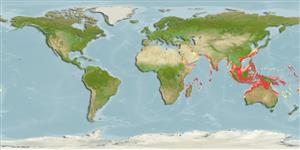Common names from other countries
Environment: milieu / climate zone / depth range / distribution range
Ecologia
marinhas; estuarina demersal; anfídromo (Ref. 51243); intervalo de profundidade 2 - 160 m (Ref. 47581). Tropical; 31°N - 27°S, 36°E - 178°W
Indo-West Pacific: Port Sudan in the Red Sea and the Persian Gulf to Japan, the Arafura Sea (Ref. 9819), and Australia.
Length at first maturity / Tamanho / Peso / Idade
Maturity: Lm 9.3 range ? - ? cm
Max length : 14.0 cm TL macho/indeterminado; (Ref. 1372); common length : 8.0 cm TL macho/indeterminado; (Ref. 3424); peso máx. Publicado: 19.00 g (Ref. 126702)
Espinhos dorsais (total): 8; Raios dorsais moles (total): 16-17; Espinhos anais 3; Raios anais moles: 14.
Found over muddy sand bottoms of coastal inshore waters (Ref. 47581). Often enters estuaries (Ref. 4833). Forms schools. Used in Chinese medicine (Ref. 12166).
James, P.S.B.R., 1984. Leiognathidae. In W. Fischer and G. Bianchi (eds.) FAO species identification sheets for fishery purposes. Western Indian Ocean (Fishing Area 51). Vol. 2. FAO, Rome. pag. var. (Ref. 3424)
Categoria na Lista Vermelha da IUCN (Ref. 130435)
CITES (Ref. 128078)
Not Evaluated
Ameaça para o homem
Harmless
Utilização humana
Pescarias: pouco comercial
Ferramentas
Relatórios especiais
Descarregue XML
Fontes da internet
Estimates based on models
Preferred temperature (Ref.
115969): 24.5 - 29, mean 28 (based on 2086 cells).
Phylogenetic diversity index (Ref.
82804): PD
50 = 0.5625 [Uniqueness, from 0.5 = low to 2.0 = high].
Bayesian length-weight: a=0.01995 (0.01577 - 0.02524), b=2.92 (2.86 - 2.98), in cm Total Length, based on LWR estimates for this species (Ref.
93245).
Nível Trófico (Ref.
69278): 2.9 ±0.3 se; based on diet studies.
Resiliência (Ref.
120179): Elevada, tempo mínimo de duplicação da população menor que 15 meses (K=0.88-2.63; tm=1.2).
Fishing Vulnerability (Ref.
59153): Low vulnerability (14 of 100).
